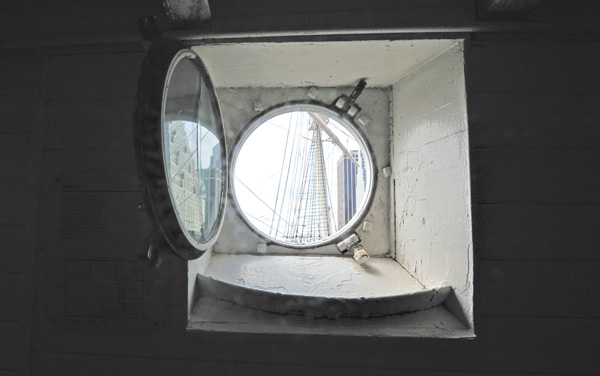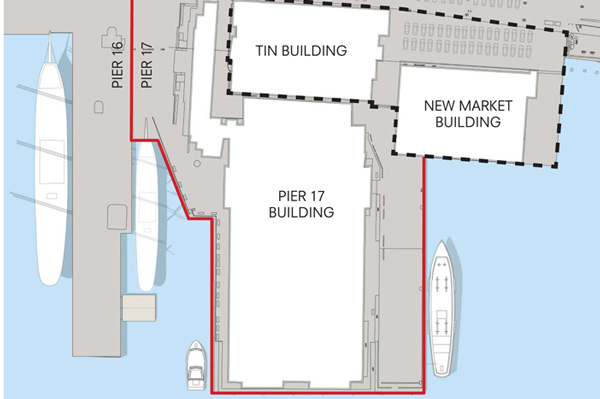
The South Street Seaport Museum’s ship, Peking, ship recently reopened for a few Saturdays (see article, P. 12), but nearby residents and community leaders are trying to get a better sense of what The Howard Hughes Corporation’s development plans mean for the museum and the rest of the Seaport.
BY TERESE LOEB KREUZER | “What was your favorite movie? Y’all went and saw a movie, I’m sure. What was your favorite movie?” asked Christopher Curry, executive vice president of The Howard Hughes Corporation as he sat in front of a room packed with Community Board 1 Seaport Committee members and members of the public on Sept. 17.
No one answered.
“Nobody saw a movie?” Curry continued.
“I went to a restaurant but I didn’t see a movie,” Seaport Committee chair John Fratta replied.
“OK. Well, what do you think was the favorite movie? Seven hundred or 800 people on the lawn? It’s been great,” Curry said affably.
He had come to the Seaport Committee, the members hoped and believed, to shed some light on The Howard Hughes Corporation’s plans to develop those parts of the South Street Seaport where it holds leasing rights in addition to its rights on Pier 17. Demolition of the existing mall on Pier 17 is set to begin Oct. 1, with a new mall expected to open in 2015. But Hughes, a Dallas-based developer, also has a long-term leasehold on many other parts of the historic Seaport, and options on parts of the uplands area not currently under lease.
According to the terms of a letter of intent signed by Hughes and the New York City Economic Development Corporation in December 2011, Hughes had to submit its plans to the E.D.C. by Aug. 31, 2013 in order to exercise those options. Hughes met the deadline. Community board members wanted to know what was in those plans.
Curry didn’t tell them and as of Sept. 23, no one had heard anything — not the Community Board and not City Councilmember Margaret Chin’s office.
Instead, Curry and Phillip St. Pierre, general manager for The Howard Hughes Corporation at the Seaport, talked about what a great summer they’d had and vaguely referenced plans for an upcoming “fall festival type of thing” in St. Pierre’s words, followed by a “winter program, which will be focused on holiday and Christmas.” In the springtime, there would be flower shows, he said.
“What about the revitalization plan for the Seaport itself?” Fratta asked. “The master plan we’ve been asking about over and over again? I understand you made a submission already?”
“Well, we’re in discussion with E.D.C.,” Curry replied. “It’s evolving and we’ll have more discussions before there’ll be anything that is — anything to be shared.”
Curry said that nothing would happen “without everyone looking at it and commenting on it and you’re not missing anything.”
“When do you expect to have that?” Fratta asked.
“I would imagine it would be sometime mid to late October. I would imagine,” Curry replied.
The committee and members of the Save Our Seaport group, who packed the room hoping to learn something substantive from Curry, are particularly concerned about the Howard Hughes options on the landmarked Tin Building and the New Market Building, which is not in the city’s historic district. They are also concerned about the possibility of a Hughes takeover of the South Street Seaport Museum properties on Fulton and Water Sts.
The museum had to close its galleries at 12 Fulton St. in April 2013 because of Superstorm Sandy damage, but is currently using all of its properties and has been sailing its 1885 schooner Pioneer this summer.
However, a Howard Hughes leasing brochure shows the museum’s properties at 12 and 14 Fulton St. as being available for lease, and “we’ve heard rumors that they’ve literally had architects who have come into 12 and 14 Fulton and have been measuring the curtains,” said Michael Kramer, a member of the Save Our Seaport group, a coalition of community groups and individuals that wants to preserve the historic Seaport.
Curry, perhaps inadvertently, fueled that speculation with one of his remarks at the Seaport Committee meeting.

In response to a comment from Community Board 1 chairperson Catherine McVay Hughes about the importance of the museum and its historic vessels to the community, Curry said, “It’s a very high priority for The Howard Hughes Corporation to figure out a long-term solution to make it a much more sustainable institution. It’s bigger than The Howard Hughes Corporation itself. We’ve had conversations with the city and we’re a willing partner to make sure that there’s long-term viability. We’re hopeful that we’ll figure out a solution.”
Those “conversations with the city” caused some people to think that Howard Hughes might take over the museum, and in fact, Kramer said that he had heard rumors to that effect.
After Curry and his team departed, Kramer and his colleague from Save Our Seaport, attorney Michael Yamin, outlined some of the implications of recent lease amendments between The Howard Hughes Corporation and the E.D.C., its Seaport landlord. These include, according to Save Our Seaport, “that the historic maritime tradition of the South Street Seaport no longer need be protected” and that there is no longer a requirement for the city and H.H.C. to “strengthen” the South Street Seaport Museum’s financial condition.
Kramer and Yamin also mentioned some of the litigation that Hughes continues to face from tenants such as Bridgewater’s, Pizzeria Uno and Heartland Brewery, whose tenancy was disrupted by Sandy but who were never able to reopen because of Howard Hughes’ failure to make their former premises available to them.
On behalf of Save Our Seaport, Kramer and Yamin asked the committee to call for a moratorium on future Seaport land use until Howard Hughes “pays all upaid rent due to the city, treats its tenants with existing leases fairly and both H.H.C. and N.Y.C.E.D.C. follow the recommendations contained in the N.Y.C. Comptroller’s audit report” of July 25.
“I don’t believe that we could put a moratorium on a land use application,” said Fratta. “We can urge them not to move forward, but we can’t put a moratorium on anything.”
He wondered whether the committee could ask City Planning to make Community Board 1 part of the process when discussions take place between Howard Hughes and E.D.C.
“That’s never happened,” CB1’s land use consultant, Michael Levine, replied.
“Howard Hughes is not being open with us. E.D.C. is equally to blame,” said Fratta. “We know that Howard Hughes is going to do whatever it can do. Howard Hughes is going to tell us to go to hell. They’ll smile at us and tell us to go to hell.”

















